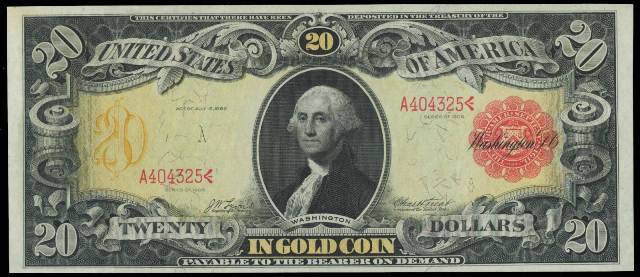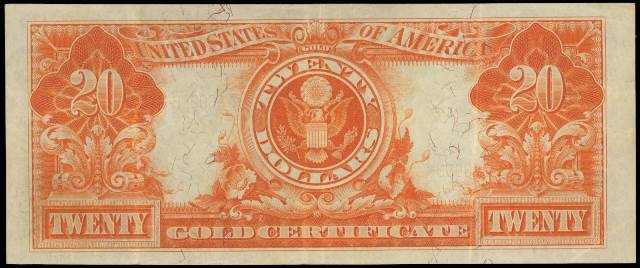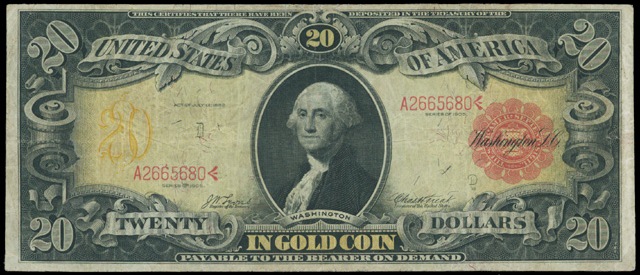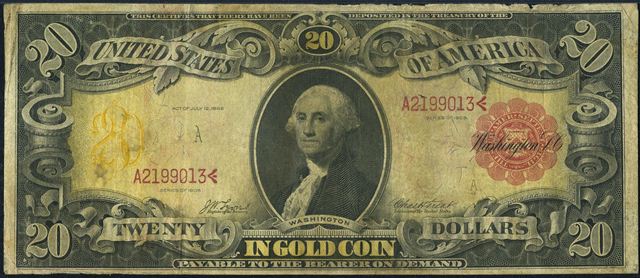Series of 1905 $20 Gold Certificate – Technicolor
History: Twenty dollar gold certificates were first printed in The United States in 1863. They were redesigned in 1882. However, it wasn’t until 1905 that we saw the gold certificates that ended up being common place in circulation in the early 1900s. The series of 1905 $20 gold certificate features a portrait of George Washington. Washington was also featured on similarly designed twenty dollar gold certificates from 1906 and 1922. The 1905 example we are discussing here is many times rarer than the later issues. It is a one year, one design type note that only has two signature combinations. It is not necessarily historically important, but it is a favorite among collectors.
Nickname: The 1905 $20 gold certificate is nicknamed the “Technicolor” note. Occasionally U.S. money had a color tint to its paper like the 1869 rainbow series. Serial numbers and seals have been all different colors as well. However, the 1905 $20 gold certificate is pretty much the only bank note that has extra color added just for the sake of the design. This was very unusual and it was discontinued when the 1906 $20 gold certificates were made. Technicolor notes are striking compared to similar issues. Even the red seal and serial numbers seem brighter than normal.
Other Facts: There are a few interesting things about the 1905 $20 gold certificate. First of all, it is one of only a few pieces of United States currency that actually has a dollar sign on it. Paper money often lags far behind coins in terms of historical significance in the opinion of the general public. Many famous politicians kept coin collections, but not many kept currency collections. There is a small exception though. Theodore Roosevelt was the president in office when the 1905 $20 gold notes were issued. He was a huge fan of them. They marked a significant change in color from what paper money had looked like for generations. The serial number #1 note was presented to Theodore Roosevelt. The #2 note was given to Leslie Mortier Shaw (the secretary of the treasury). The #3 note was given to Gilbert G Thorne. Other low serial number notes are also known to exist. So this isn’t an issue that just happened to become popular years after it was originally printed. It has been important since day one.
Values and Grading: All series of 1905 $20 gold certificates are at least rare. Most bills are valued between $500 and $4,000. Something that is really special could be valued higher. However, it would have to be in absolutely perfect condition to be worth above the $10,000 price point. No star notes were issued, so that will never enter the equation. As we mentioned above, some low numbers are out there. A low number could add a premium, based on condition. There are two signature combinations. Your note will be signed by either Lyons and Roberts or Lyons and Treat. Our picture and grading guide has more information about values (see below).
Choice Uncirculated or Better: 1905 $20 gold certificates in perfect condition are what most dealers and collectors would consider an investment grade collectible. A few dozen are known to exist and they are extremely valuable. Prices range from $20,000 to mid-five figures. The price points within that range are based on centering, color, and minor things like embossing. Of course to command that kind of money the note has to truly be uncirculated. It can’t just look nice. It has to be graded and authenticated by a third party. This is not the type of note you are likely to find in an old book or dresser drawer, but stranger things have happened.

All Of The Details Pop On This 1905 $20 Gold Certificate
Extremely Fine to About Uncirculated: There is definitely a shortage of 1905 $20 gold certificates in the grade of XF 40 to AU 58. It seems that most notes that are currently available on the market are either in perfect condition or very heavily circulated condition. There isn’t much middle ground. Technicolors that are XF or AU are very expensive. You should expect to spend between $5,000 and $12,000 for something like this. In order to meet the grading criteria, these notes need to be almost perfect. A couple of light folds are acceptable, but not much else. Most notes like this will appear brand new to the casual observer, but a trained-eye will be more critical.

You Can See Folds At The Quarter Lines On This 1905 $20 Bill
Fine to Very Fine: There is a huge price gap between technicolors in fine 12 and very fine 35. The grade of fine 12 implies well used and soft paper. A 1905 $20 bill in VF 35 condition could look almost brand new. There is a strong demand for problem free notes in this grade range. Notes that are graded accurately and have lots of eye appeal will always sell well no matter if they are graded a 12, 35, or something in between.

This 1905 $20 Gold Certificate Is Circulated But Still Very Attractive
Very Good and Lower: We see lots of 1905 $20 gold certificates in this grade. They generally sell for between $500 and $1,000. That is still a lot of money for some collectors and many people have to settle for something in that grade. If you are putting together a type set then you have to have a 1905 $20 bill, so some grade sacrifices are occasionally made. Expect to find notes with tape, stains, tears, ink, rust, ragged edges, etc. That is usually expected for the fair, poor, about good, good, and very good grades.

Most Technicolor Notes You Find Are Going To Be Well Used Like This Example
Need an Appraisal or Offer? We buy any and all 1905 $20 gold certificates. We are most interested in higher grade examples in fine or better condition; but that doesn’t mean that we won’t buy low grade notes as well. Send us scans or digital photos of what you have available and we can go from there. Sales@AntiqueMoney.com


